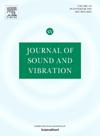An active learning Kriging-based Bayesian framework for probabilistic structural model exploration
IF 4.3
2区 工程技术
Q1 ACOUSTICS
引用次数: 0
Abstract
The Bayesian framework in structural health monitoring includes both modal identification and model exploration. Probabilistic model exploration, also named as model updating, can effectively estimate the structural parameters and quantify their uncertainties. However, it can be computationally intensive on application to real-world large-scale structures. Meta-models, e.g. Kriging models, can help tackle this challenge but they also introduce more uncertainties. In this paper, a novel Bayesian framework combining the active learning Kriging approach is proposed. The framework comprises three major components: the improved fast Bayesian spectral density approach for modal identification, the active learning Kriging method for meta-modelling, and the Bayesian structural model exploration. The Transitional Markov Chain Monte Carlo algorithm is implemented throughout the framework to sample the posterior distributions. The uncertainties from three aspects, i.e., (1) measurements, (2) meta-model construction and (3) finite element modelling, are considered in definition of the likelihood function adopted in both the active learning and model exploration processes. Compared with the ordinary Kriging model and adaptive Kriging approach using U function, the proposed active learning method significantly reduces the uncertainties of the Kriging predictor and improves its local prediction performance with fewer samples. The proposed framework is validated by a continuous test beam in the laboratory and applied to a real-world cable-stayed bridge using structural health monitoring data. A mode-matching criterion is used to overcome the difficulty of closely spaced modes in model exploration of the cable-stayed bridge. As the proposed framework is data-driven, no weighting hyperparameters are required. The active learning Kriging-based Bayesian framework can directly process structural dynamic time history response and conduct probabilistic model exploration with multiple uncertainties included, and therefore is promising in application to major structures.
基于 Kriging 的主动学习贝叶斯框架,用于探索概率结构模型
结构健康监测中的贝叶斯框架包括模态识别和模型探索。概率模型探索(也称为模型更新)可以有效地估计结构参数并量化其不确定性。然而,在应用于真实世界的大型结构时,这种方法的计算密集度较高。元模型(如克里金模型)可以帮助解决这一难题,但也会带来更多的不确定性。本文提出了一种结合主动学习克里金方法的新型贝叶斯框架。该框架由三个主要部分组成:用于模态识别的改进型快速贝叶斯谱密度方法、用于元建模的主动学习克里金方法以及贝叶斯结构模型探索。整个框架采用过渡马尔可夫链蒙特卡洛算法对后验分布进行采样。在定义主动学习和模型探索过程中采用的似然函数时,考虑了三个方面的不确定性,即 (1) 测量、(2) 元模型构建和 (3) 有限元建模。与普通克里金模型和使用 U 函数的自适应克里金方法相比,所提出的主动学习方法显著降低了克里金预测器的不确定性,并以更少的样本提高了局部预测性能。通过实验室中的连续测试梁对所提出的框架进行了验证,并利用结构健康监测数据将其应用于现实世界中的斜拉桥。在对斜拉桥进行模型探索时,采用了模式匹配准则来克服模式间距过近的困难。由于所提出的框架是数据驱动的,因此不需要加权超参数。基于 Kriging 的主动学习贝叶斯框架可以直接处理结构动态时间历史响应,并在包含多种不确定性的情况下进行概率模型探索,因此在大型结构中具有广阔的应用前景。
本文章由计算机程序翻译,如有差异,请以英文原文为准。
求助全文
约1分钟内获得全文
求助全文
来源期刊

Journal of Sound and Vibration
工程技术-工程:机械
CiteScore
9.10
自引率
10.60%
发文量
551
审稿时长
69 days
期刊介绍:
The Journal of Sound and Vibration (JSV) is an independent journal devoted to the prompt publication of original papers, both theoretical and experimental, that provide new information on any aspect of sound or vibration. There is an emphasis on fundamental work that has potential for practical application.
JSV was founded and operates on the premise that the subject of sound and vibration requires a journal that publishes papers of a high technical standard across the various subdisciplines, thus facilitating awareness of techniques and discoveries in one area that may be applicable in others.
 求助内容:
求助内容: 应助结果提醒方式:
应助结果提醒方式:


